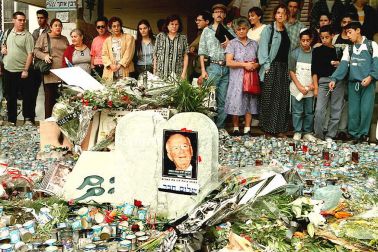Olivia Glazebrook’s first novel begins with a disaster.
Olivia Glazebrook’s first novel begins with a disaster. Kit, painter of meretricious society portraits, has whisked Alice, his younger, pregnant girlfriend, off to Jordan for an indulgent weekend. Their car skids off a mountain road leaving Alice trapped inside. Kit behaves like an unheroic imperialist. ‘You bloody little man, Karim!’, he yells at the driver, but it is Karim who reminds him that they ought to be aiding Alice. They are rescued, but not all the artifice of a luxury hotel can prevent Alice’s miscarriage. Blood pours out of her ‘as if she were a vase, carelessly knocked over on a table.’
Glazebrook is good with similes. The image of the vase mirrors the impact on their relationship of the loss of the unborn ‘Bean’. The shape of their shared life is broken; meaning collapses, and the rich, handsome couple are stranded in an emotional wasteland more sterile than the Jordanian desert.
Miscarriage features disproportionately rarely in novels, considering what a common catastrophe it is. The Trouble With Alice demonstrates with painful clarity how the loss exposes and widens existing unsuspected faultlines. Alice and Kit cease to communicate. Alice stops eating. She embarks on the anorexic’s timetable of deceits and self-punishments, intent on creating ‘a new version of herself’, one beyond the reach of others. Her only companion is Kit’s old lurcher, Bones.
Alice attempts to shut out the guilt and grief, the feeling that she failed her baby. Kit, only ever falsely enthusiastic about the pregnancy, reverts to bachelor selfishness —an easy step for him. One problem for me was the unlikeability of Kit, who does little more than say ‘Fuck’ a lot, smoke, and get irritated by people who make demands on him. He hardly notices when Alice moves out of the bedroom of his smart Notting Hill house and entombs herself in the basement with Bones.
Such desolation, however acutely described, seems doomed to make for a static and unrewarding novel. But Kit’s father, Tod, comes to the reader’s rescue, furious, wheelchair-bound, sparking dangerously like a malfunctioning firework. Tod is a great tragi-comic creation, a monster of manipulative spite only dimly aware that he is losing his power to harm.
Tod was the designer of his day. Kit’s covetable house is really Tod’s house; Tod designed everything in it, down to the teaspoons. It’s obvious where Kit gets his horridness from. Tod’s emasculating control of his son’s life is encapsulated by the glass bowl, designed, of course, by him, in which two goldfish, ‘Kit’ and ‘Alice’, circle drearily.
Tod’s announcement that he will sell the house breaks the stasis. Alice and Bones withdraw to Cornwall, where Kit’s hippy ex-model mother Iona built a new life after abandoning the young Kit to his brutal father. If Iona offers Alice a haven, can she repair this damage? Can the shake-up save Kit from turning into a version of his father? Reduced to camping on a friend’s child’s bed, Kit is forced to wake up and take stock. The ousted child plays an important part in his rehabilitation.
This is a careful, sensitive novel, perhaps over-schematic in its desire to illustrate its central theme, which is that if the wellsprings of sympathy are blocked, human beings suffer morally as they would suffer physically from lack of water in a desert. The prose sometimes wavers between predictability — ‘Dear God, he thought, I’ll do anything if you’ll get me out of this, I really will’ — to precise, original observation. I don’t want to spoil the story, but the last scene in which Bones appears is particularly powerful. Luckily, the balance tips in favour of originality. As a first novel, this is pretty good; Olivia Glazebrook’s next will be even better.





Comments